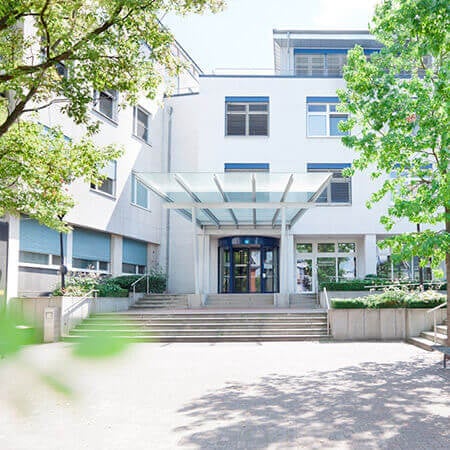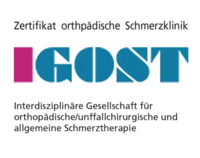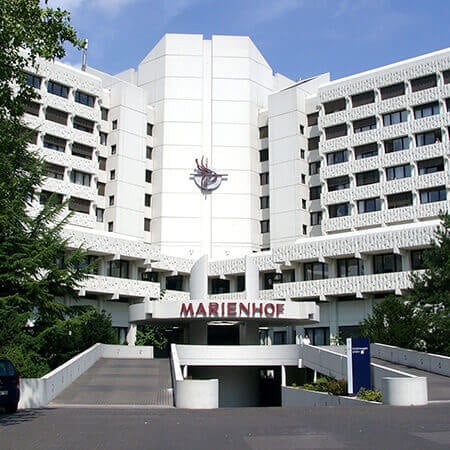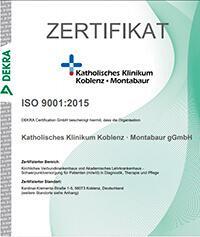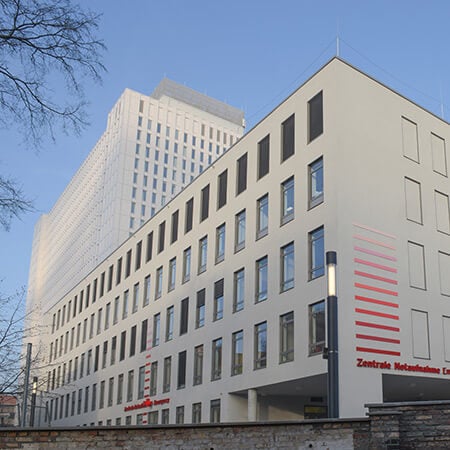Pain in the neck and head region often causes patients to seek medical help. The discomfort may indicate not only injury, but also other serious complications, including cervical herniated discs. It is important to know what can be done when a cervical herniated disc occurs. It is also worth knowing what symptoms can make you suspect a cervical herniated disc.
Content
- Symptoms and diagnostics
- Conservative treatment
- Surgical options of treatment in European hospitals
- Nucleotomy
- Complications of untreated cervical herniated discs
- Treatment in European hospitals
- The cost of treatment
Symptoms and diagnostics
The cervical herniated disc is accompanied by such peculiar symptoms as nerve root spasms, weakness, and loss of sensation and reflexes. The most common signs of cervical hernia are pain in the arm or shoulder of the affected side, weakened muscle tone in the area of nerve impingement, and reduction or complete loss of deep tendon reflexes. The weakening of muscle tone depends on the degree and duration of nerve impairment. There may also be a loss of sensation in the corresponding part of the body, which is usually accompanied again by the weakening of the muscle tone. The advanced stages may be characterized by such symptoms of myelopathy (neurological impairment of the spinal cord) as impaired walking, spasticity, as well as various hyperactive and pathological reflexes.
Diagnosing this health condition requires a careful examination of the medical history, as well as neurological and radiological examinations, correlated observation. The first step in establishing the diagnosis is an X-ray scan. It will provide an opportunity to examine not only the cervical intervertebral area, but also diseases and disorders that have similar symptoms to cervical herniated discs, for example, spinal cord fractures and malignant tumors. If there is suspicion related to bone structure abnormalities, cervical imaging should be preferred. Magnetic resonance imaging of the cervical spine is the preferred method of diagnosis for patients with suspected myelopathy. At the same time, the use of this method alone is considered sufficient for diagnosing patients with corresponding neurological signs.
The following information is important in the diagnosis of intervertebral hernia:
- Information about the onset of pain.
- Time period since the onset.
- Mechanism of injury.
- Percentage of targeted and peripheral pain (for example, 90% neck pain versus 10% pain in the upper extremity).
- Associated symptoms (fever indicates infection, weight loss suggests malignancy), and any other complaints.
When conducting diagnostics, doctors usually assess:
- The patient's range of motion, as it may indicate the severity of pain and degeneration of the herniated disc of the cervical spine.
- Neurological status (evaluation of sensory disturbances, motor weakness, and tendon reflex abnormalities).
- Identification of any signs of spinal cord dysfunction.
Cervical spinal disc herniation is disc damage with the protrusion of its inner part outward.
Treatment includes medications, massage and physical therapy, surgeries.
Cost of treatment with endoscopic or microscopic nucleotomy is from €3,095. You can find other prices on the Booking Health website.
The best hospitals in Europe are:
- University Hospital Rechts der Isar Munich
- University Hospital of Ludwig Maximilian University of Munich
- Clinic of Advanced Biological Medicine Frankfurt-am-Main
- Helios Hospital Berlin-Buch
- University Hospital Frankfurt-am-Main
Conservative treatment
Treatment for cervical spinal disc herniation in Germany ranges from conservative approaches, such as targeted exercises to improve function and epidural injections for pain relief, to more invasive options like herniated disc surgery when necessary. Conservative therapy is aimed at controlling pain in the acute period. For this purpose, symptomatic and short-term treatments with medication for cervical disc damage are indicated.
The purpose of such a therapy is to facilitate the transition from the acute condition. During an exacerbation, drugs of such pharmacological groups are prescribed:
- Nonsteroidal anti-inflammatory drugs. NSAIDs quickly and effectively relieve pain associated with inflammation in the cartilage or joint tissue. It is possible to take these drugs for no more than two weeks.
- Corticosteroids. These drugs are recommended in case of ineffectiveness of NSAIDs. Drugs of hormonal action are injected into the joint cavity or intramuscularly. In the case of herniated cervical discs, long-acting medications are recommended.
- Myorelaxants. They are designed to relax the spasmed muscles of the back. During the acute period, massages are forbidden, so medication should be used. On average, the course lasts several weeks.
- B-vitamin complex. A combination of B1, B6, and B12 in high doses has analgesic and restorative effects in the presence of lumbago (lower back pain) or neck pain. As part of a complex treatment, injectable vitamins improve well-being and increase vitality, thereby helping to eliminate pain when nerve roots are compressed.
Surgical options of treatment in European hospitals
A severe course of cervical herniation may be an indication for surgical treatments. If no significant improvement is observed during several months of conservative therapy for cervical herniated disc, the patient is offered surgery. Also, if the cervical disc is severely damaged, and the size of the hernia exceeds 7 mm, spine surgery is mandatory. The small size of the mass located in the cervical spine is not an indication for surgery.
Among the existing techniques of spine surgery used to restore the functionality of the cervical spine, decompression tactics have become the most widespread. They are used in cases of compression syndrome, that is, when the pathological defect that occurred within the specific vertebrae produces pressure on the nerve roots, arteries, spinal cord, and other structures in the corresponding area. The following techniques can be used as a therapy for cervical herniated discs:
- Microsurgical discectomy (excision of an intervertebral hernia with partial or total removal of the cervical herniated disc performed using a surgical microscope).
- Laminectomy (partial or total resection of the vertebral arch, facet joints, and ligaments).
- Endoscopic spine surgery (a technique that uses an endoscope inserted through miniature access; it is often prescribed for hernias, degenerative disc disease, or malignant tumors).
Stabilizing surgical tactics are also used at the cervical spine levels, each of which, by the way, can go together with other types of surgery. The most common stabilizing techniques are:
- Arthrodesis (artificial disc replacement).
- Vertebroplasty (a surgical procedure that involves injecting a cement solution into the damaged cervical area to restore its integrity and strength).
- Transplantation (implantation of a fragment of bone tissue taken from a patient to consolidate the effect after surgery).
While fusion surgery is sometimes recommended for severe cases, German hospitals also offer advanced disc replacement techniques, with the herniated disc surgery cost varying based on the specific procedure and hospital, but often being more affordable than in some other countries due to Germany's efficient healthcare system.
Nucleotomy
Nucleotomy is the most nonaggressive surgical procedure used for cervical herniated discs. Manipulation is performed through a tiny (up to 5 mm) puncture, usually under local anesthesia. Indications for this procedure are small disc prolapses at the protrusion stage, combined with chronic pain in the cervical spine.
The method is based on the impact of a certain type of radiation. Radiation currents are delivered through an electrode inserted inside the herniated disc along with fluid. All varieties of nucleotomy involve the destruction of approximately 15% of the total volume of the affected tissue, which results in a decrease in intradiscal pressure. As a result, the deformed discs return to the normal position, with their parameters being restored, and pain syndrome gradually disappearing.
Nucleotomy usually does not involve hospitalization: a person after a couple of hours can go home on their own. Rehabilitation is usually quick and goes without complications.
Complications of untreated cervical herniated discs
If untreated, a cervical herniated disc can cause a general deterioration of health, and provoke other specific complications.
Complications of herniation can cause great discomfort to the patient in the form of:
- Arm weakness and movement disorder. Sometimes the complication is so pronounced that the patient cannot do basic movements. There is also decreased mobility of the muscles of the arms and upper shoulder girdle. The most severe variant of the development of the pathology is paralysis of the arms or paresis (impaired muscle movement) due to the complete overlapping of the nerve endings by the herniated disc.
- Impairment of sensitivity of the skin. At first, the patient feels increased sensitivity of the extremities of the upper shoulder girdle, which decreases over time. This is followed by a decrease in sensitivity on the fingertips, and then the hands and forearms are affected, up to complete insensitivity of the hand.
- Spine nerve impingement, that may result in spinal cord compression. When such a complication occurs, serious medical attention is required. Some pinch locations can cause paralysis, leading to death.
Treatment in European hospitals
The patients suffering from cervical herniated discs are advised to look for a hospital that efficiently uses both conservative and surgical treatments for herniated discs. Herniated discs very often represent a borderline indication between conservative and surgical therapy. And if you have that "borderline case", with an unprofessional approach, you might be immediately put on the operating table, although the same condition could be successfully managed with conservative methods.
Besides, in a specialized hospital, unlike a regular one, doctors collect a complete medical history, conduct a thorough clinical examination, which is incredibly important. Without the absolute indications to perform surgery right away, doctors will first carry out conservative therapy, because they understand that surgery puts stress on the body, to say the least.
Treatment in European hospitals not only ensures the use of highly effective methods of therapy, but also modern rehabilitation methods. Each patient receives an individual scheme of rehabilitation therapy, which is monitored by experienced specialists. That is why you can find only positive feedback about the treatment in European hospitals.
We recommend to opt for the hospitals below that specialize in the treatment of cervical disc herniation:
- Hospital Neuwerk Moenchengladbach, Germany.
- Catholic Clinic Koblenz-Montabaur, Germany.
- Charite University Hospital Berlin, Germany.
- Beta Klinik Bonn, Germany.
- University Hospital Freiburg, Germany.
You can find more specialized European hospitals on the Booking Health website.
The cost of treatment
Prior to the actual arrival at the hospital, it is difficult to predict the exact cost of treatment to be conducted. It will depend on the number of diagnostic tests done, therapeutic procedures prescribed, the need for hospitalization and optional rehabilitation, and other nuances. The cost of treatment of cervical herniated disc in European hospitals is usually calculated after the confirmed diagnosis and approved treatment plan. However, the average prices will give an idea of what to expect financially.
The average price for a diagnostic test for cervical disc herniation starts at 499 EUR.
The price of nucleotomy (1 segment) starts at 3,095 EUR.
The price of nucleotomy (2 – 3 segments) starts at 5,215 EUR.
The price of nucleotomy (4 segments) starts at 5,162 EUR.
The price for a discectomy and intervertebral disc replacement surgery starts at 7,386 EUR.
Feel free to contact Booking Health for any information regarding the treatment of cervical disc herniation.
Please leave your request on the website and a medical advisor will contact you as soon as possible.
Authors:
The article was edited by medical experts, board-certified doctors Dr. Vadim Zhiliuk and Dr. Sergey Pashchenko. For the treatment of the conditions referred to in the article, you must consult a doctor; the information in the article is not intended for self-medication!
Sources:
Medscape
Science Direct
Web MD
